For some people, the meaning of life seems forever to be bound together with a quest for the perfect yacht tender. There is no such perfection, of course, since the just-right fit for one person will be completely wrong for the next, and boatbuilders and boat owners seem never to lack opinions. These days, however, it seems a great many people find perfect contentment with a less-than-comfortable, less-than-attractive inflatable with an outboard, and they are to be found trailing astern of even the most elegant classic yachts. And yet others have never faltered in their quest, and they know without hesitation the characteristics of a fine tender when they see one.
Such is the case for Sunshine, a Walter Simmons design based on a 1915 boat a client brought to him for restoration years ago. Simmons delivered the bad news that the boat was too far gone to restore—better, he advised, to take what was good about her and build a new boat. He proceeded to take the lines of the original hull, which had been built in Stonington, Maine. During some available winter hours, he faired up the lines and worked up construction details.
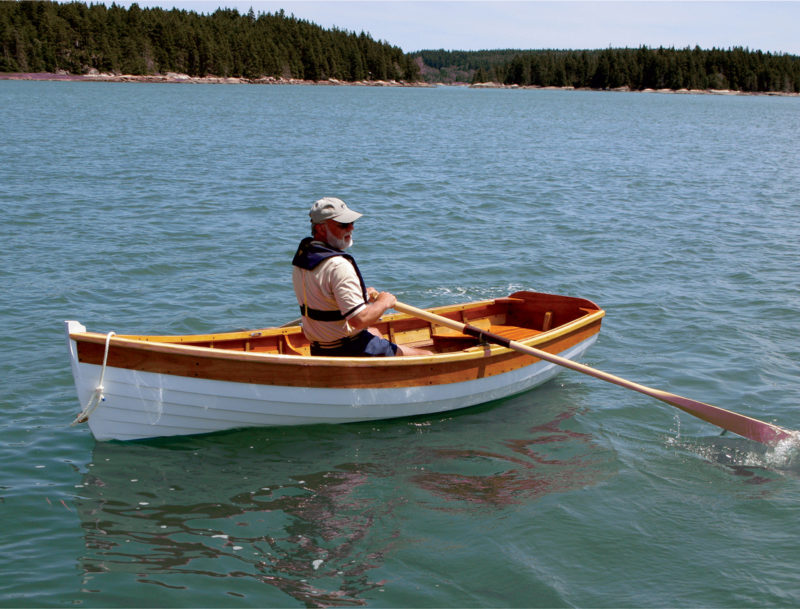 Photo by Tom Jackson
Photo by Tom JacksonWith excellent load-carrying capacity and rowing characteristics, low weight, and great looks, the Sunshine design makes a wonderful yacht tender.
What was good about the original has been universally hailed by all who have used the boat before or since. She’s burdensome, but not at all ungainly, 10’6″ boat with a 4′ beam, about 6″ more or less of draft, and very seakindly ways. “She just does everything you want her to do,” Simmons says. “She’ll take any load, any way you want, and would ride the back of a stern wave all day long.” Simmons himself has built about 40 of the boats, and he has sold plans to builders far and wide, some as far away as New Zealand. Many more boats have been built by those who bought the plans.
For anyone driving the winding road down to Brooklin, Maine, in recent years, a small roadside sign saying “North Brooklin Boats,” and often a boat itself, would always catch your eye. Eric Jacobssen, the proprietor, decided some time ago that he was going to pursue his ambition of starting a small-boat business. The first design he looked at (with some friendly advice from his friend Mike O’Brien, former senior editor with WoodenBoat) was Sunshine.
“It’s a truly great boat,” Jacobssen says. “I’ve never ever for one moment been unhappy with the boat I chose. It looks nice, and it really rows superbly. Good yachtsmen have confirmed that for me.” He builds boats the way he prefers to: pick a good design, build it well, and the clients will follow. He has built 15 of the boats by now, and every piece is patterned and jigged up. But still, he estimates that it takes him 300 hours of work to build one, given the quality of work and finishes he strives for. “There are some shortcuts I could take, but I just feel it’s not what the market wants in this boat. It just takes more time, but it’s just kind of what I feel like doing.”
Art Rocque was one of the people who noticed Jacobssen’s shop, after driving home “the long way” to Stonington one night after dinner. He had recently had his wooden-hulled Egg Harbor 27 restored, and when he saw a Sunshine alongside the road in front of Jacobssen’s house, he saw what he wanted to have hanging from his davits. He called to inquire about the boat, which had already been sold. But, yes, Jacobssen could surely make another.
I walked with Rocque down the mossy trail to the shore from the home his grandfather had built on Deer Isle, Maine. The boat was as lovely as could be, trailing from an outhaul. Hauled ashore to a little scrap of sand between the rocks, she nosed in easily, allowing a dry-feet entry.
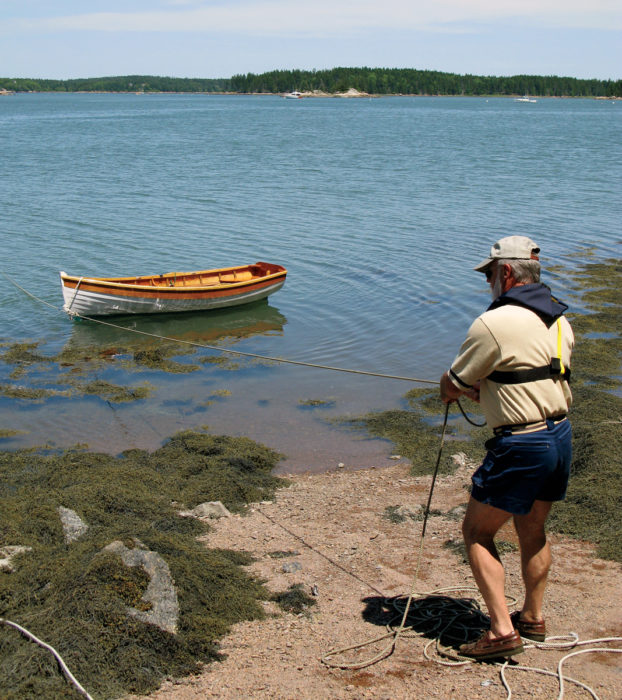 Photo by Tom Jackson
Photo by Tom JacksonDrawing only inches, the tender can easily be brought ashore by an outhaul—and the same characteristic would make her a great gunkholing boat.
I took a turn at the oars, and I can fully attest that she’s a fine rowing boat. She balances very well with two people aboard, and she gave the impression of being ready for much more. The freeboard seems just right to me for a tender—with a good load of all the cruising provisions and a couple of guests, she would still row very comfortably. I wasn’t able to try a sailing version of the boat, but I’d be willing to wager that she’d be a fine gunkholer, too, just the ticket for getting into those tight, private spaces and tempting beaches where the big boats can’t go. She has the stable and solid feel of a no-nonsense boat going about her task with competence and honesty.
Rocque had Jacobssen fit lifting rings to the boat—two on the transom and one at the inside of the forefoot near the stem—so she can easily be hauled out of the water with the block-and-tackle rigged to davits on his big boat. At about 120 lbs, the boat comes aboard easily. He later also had Edgecomb Boat Works install a stainless-steel bracket on the Egg Harbor’s rail aft, into which a fitting on Sunshine’s gunwale slips, easily allowing the boat to be held very securely in position.
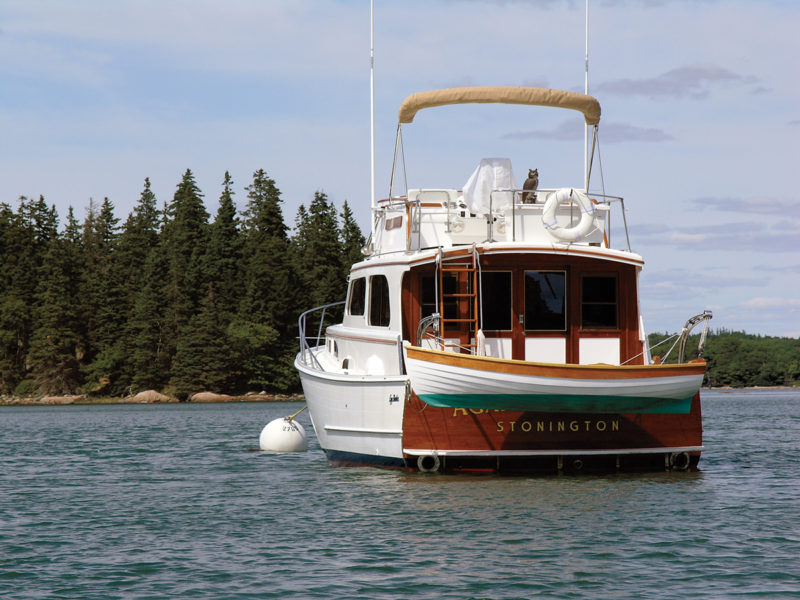 Photo by Carol Rocque
Photo by Carol RocqueHanging in davits off the stern of a finely restored Egg Harbor 27, the tender looks right at home.
“She hangs on davits very easily,” Rocque says. “She actually tows, and if you’ve ever towed a tender, you know what a pain in the rear end that can be. If you give her enough tether, she will tow perfectly straight and stay dry. People walk by and say, ‘Geez, that’s a wonderful little tender,’ which is always better than having an inflatable hanging off the stern. What would it look like having an inflatable right here? They have no shape, they’ve got no style. You can’t row them, so you’ve got to have an engine on it. They’re nasty as hell if you’ve got anything resembling a chop. They don’t carry any type of load. And as I say, when was the last time you had somebody walk past a plastic inflatable and say, ‘Boy, that’s a nice- looking dinghy’?” Strike three.
Rocque purposely avoided having a sailing rig, too. The man likes to row. “She doesn’t need a sailing rig,” he says. She balances so well on the oars—a fine pair made by Shaw & Tenney in Orono, Maine—that he sees no need for any further propulsion. Taking to heart family concerns that maybe he was rowing too much, he bought a 5-hp outboard for one of his earlier boats. “I have actually contemplated using it for a mooring block. It’s noisy, it’s smelly, it’s not fun to run, and it cavitates like hell unless the balance is exactly right. In fact, Eric asked if I wanted to use an outboard on this boat; he would have been willing to make some modifications. I told him, ‘Not likely—not even at gunpoint.’” Now, that’s Eric Jacobssen’s kind of customer, and no doubt Walter Simmons would nod his approval, as well.![]()
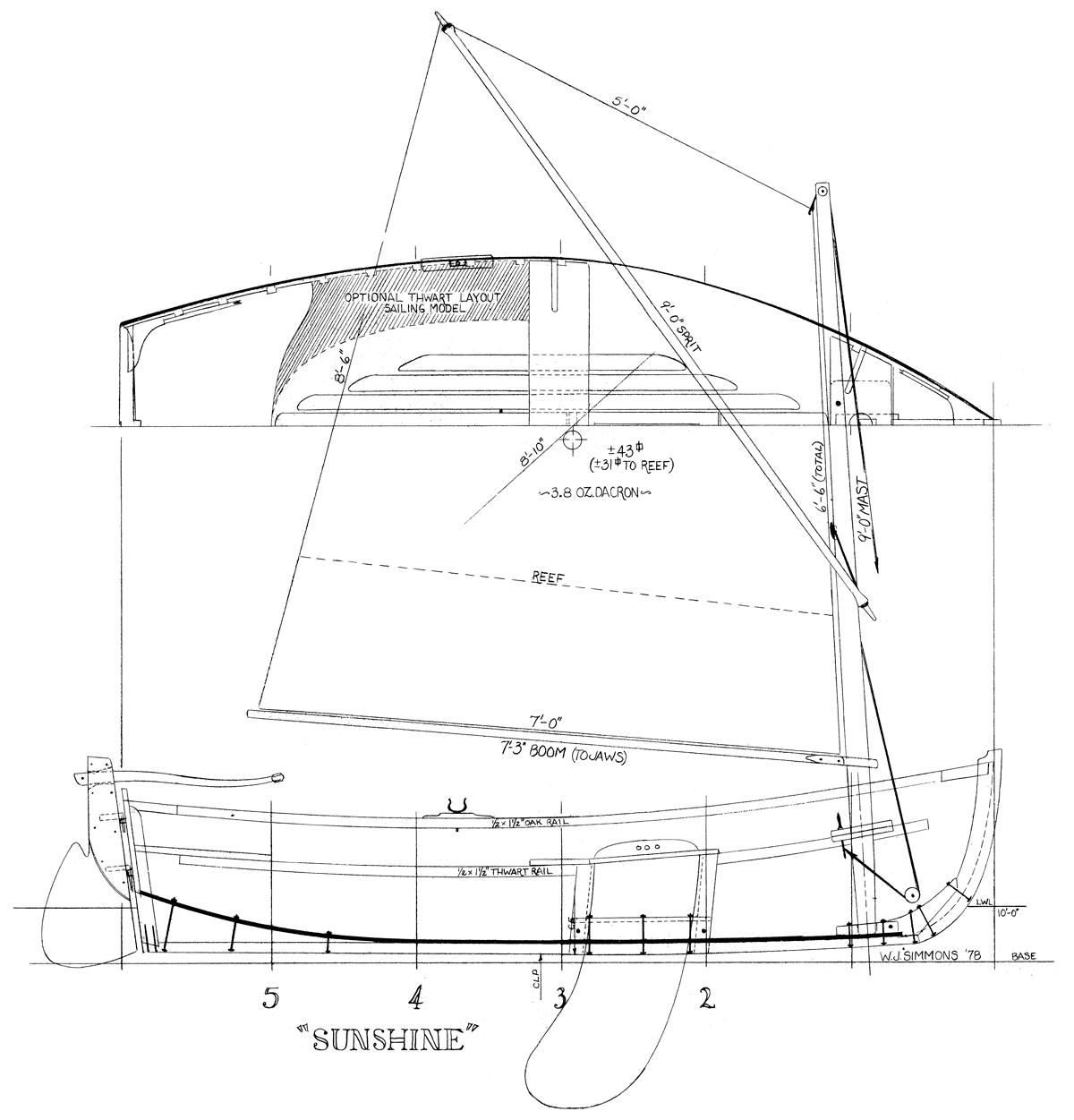
Walter Simmons of Duck Trap Woodworking in Lincolnville Beach, Maine, based his Sunshine design on a 1915 boat. So good were her qualities that Simmons ended up building 40 of the boats for clients.
This Boat Profile was published in Small Boats 2009 — for more information and to purchase plans, visit Duck Trap Woodworking.
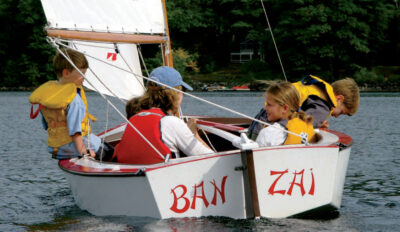
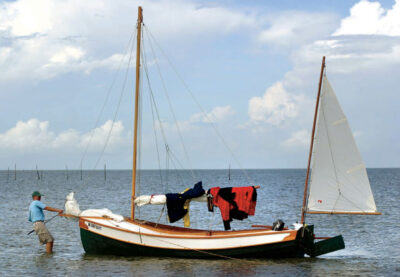
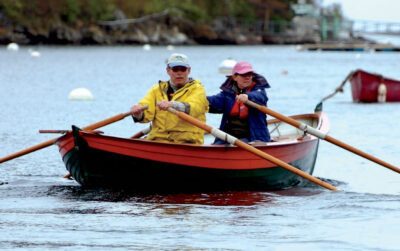
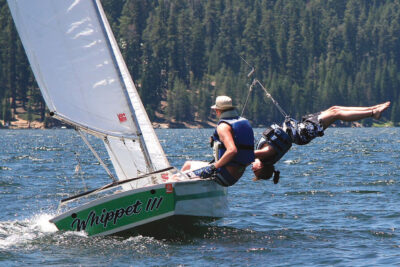
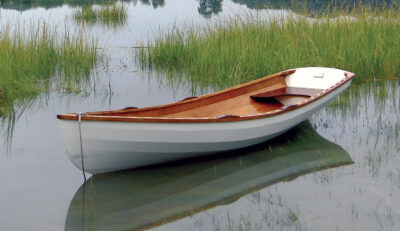
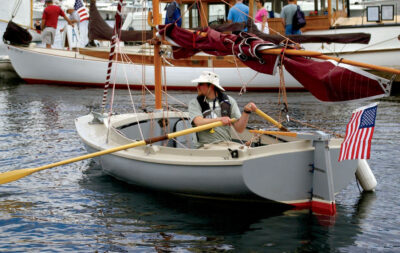
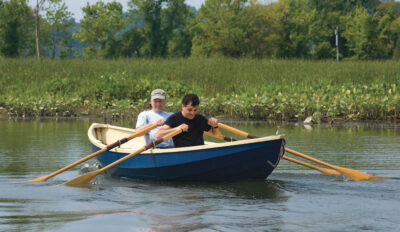
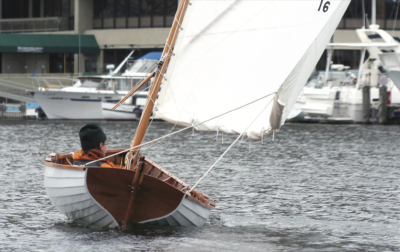
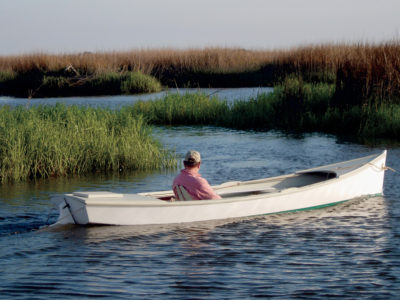
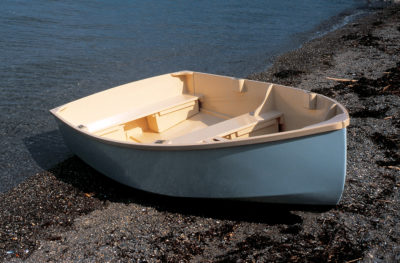


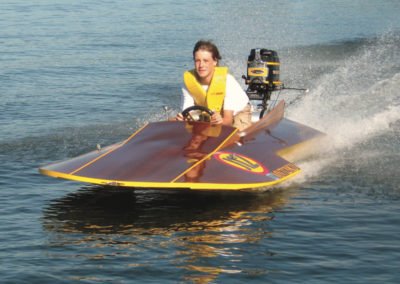
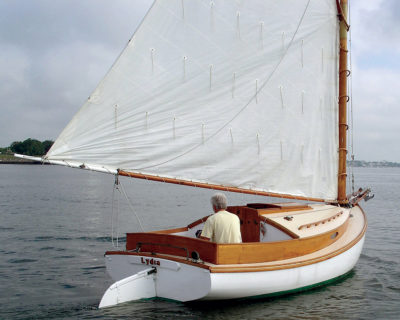
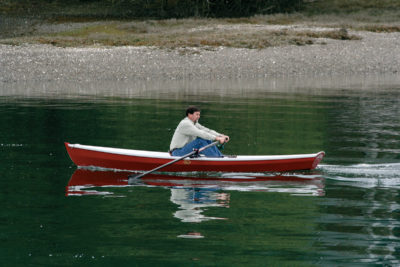
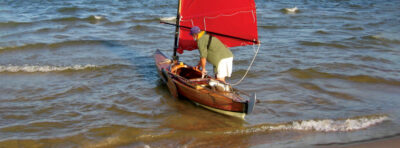
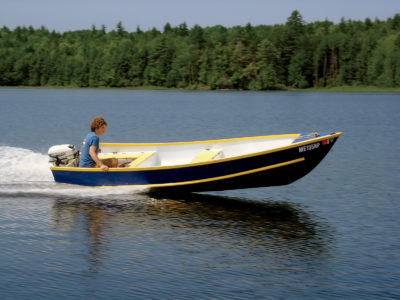
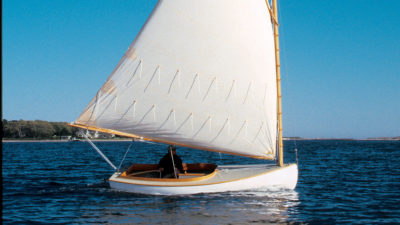
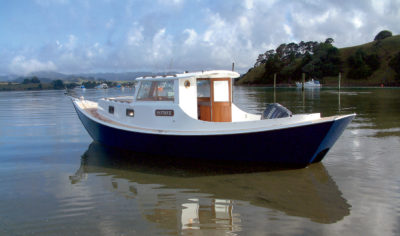

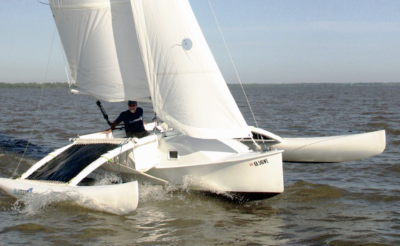
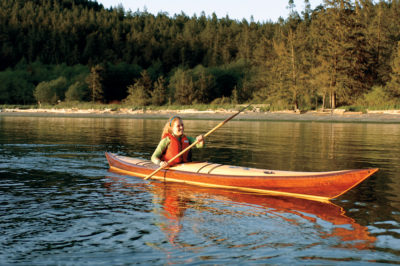
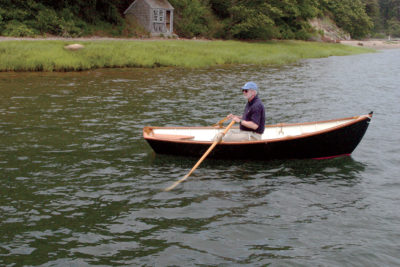
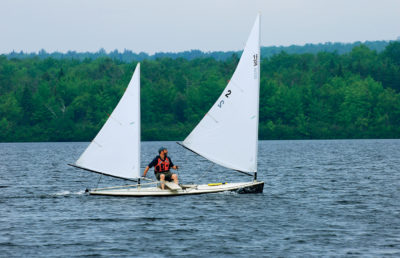
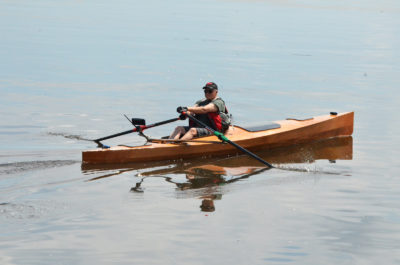

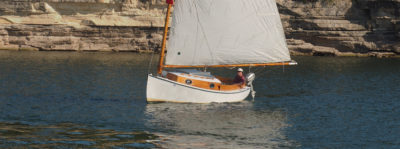
Me thinks that is a 37, not 27, Egg Harbor. Sunshine is a beautiful design. Just not enough time in one man’s life to build all the beautiful ones!